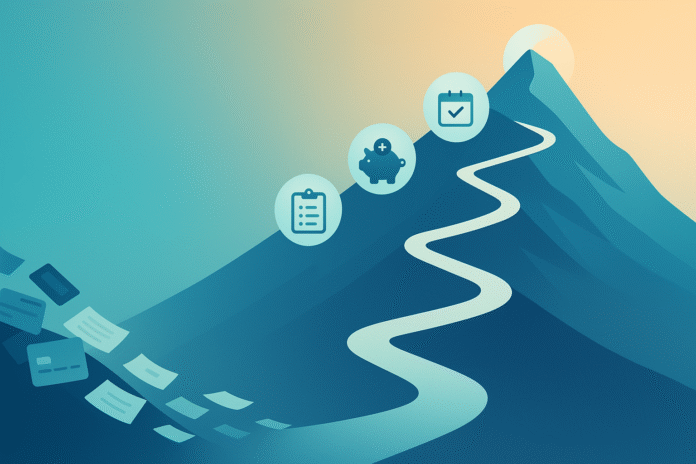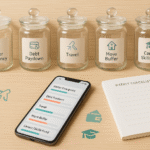If you’ve decided it’s time to stop bleeding money to interest, the debt avalanche strategy is your most efficient route to freedom. By targeting your highest-interest balances first while keeping minimum payments on everything else, you’ll shrink what you owe faster and pay less over the life of your debt. This guide breaks the process into five practical, beginner-friendly steps you can start today—even if your budget is tight, your income is irregular, or your debts feel overwhelming.
Disclaimer: This guide is for educational purposes only and isn’t individualized financial, legal, or tax advice. Consider consulting a qualified professional for recommendations tailored to your situation.
Key takeaways
- Avalanche = efficiency: Pay the least interest by prioritizing debts with the highest APR while maintaining minimums on all accounts.
- Systems beat willpower: Automate minimums and schedule one extra “avalanche payment” every month so progress happens on autopilot.
- Budget fuels the avalanche: The size of your extra payment depends on a realistic spending plan and a small emergency buffer.
- Protect your credit and cash flow: Pay on time, watch promotional terms, and avoid actions that spike your utilization or trigger penalty rates.
- Adapt as you go: Track APR changes, review balances monthly, and pivot to options like hardship plans, credit counseling, or balance transfers when appropriate.
Step 1: Map Your Debt Landscape With Ruthless Clarity
What this is and why it matters
You can’t run an avalanche without a mountain to descend. Step 1 is building a complete picture of your debts—every balance, interest rate (APR), minimum payment, and due date—so you know exactly where your money is going and which balances are costing you the most. Clarity helps you avoid late fees, protect your credit, and ensure your avalanche is aimed at the right target.
Core benefits
- Shows which balances are most expensive.
- Reveals quick wins and risk areas (e.g., promo rates ending soon).
- Prevents missed payments and penalty APRs.
- Creates the source data you’ll use for automation and tracking.
Requirements and low-cost alternatives
- What you need: Recent statements (paper or PDF), online account logins, a simple spreadsheet (Excel/Google Sheets), or a notebook.
- Nice-to-haves: A free credit report for cross-checking open accounts, a calculator, and a calendar app for reminders.
- Low-cost alternatives: Use a printed worksheet, a whiteboard, or the notes app on your phone if spreadsheets feel intimidating.
How to do it (step-by-step)
- List every debt with five columns: Lender, Balance, APR, Minimum Payment, Due Date. Include credit cards, personal loans, BNPL plans, private student loans, and any other revolving or installment debt (exclude mortgages for most avalanche plans unless they carry unusually high rates).
- Mark special terms: Note any introductory 0% or reduced APR promotions, deferred-interest offers, or variable-rate loans tied to a benchmark (e.g., Prime).
- Separate by type: Flag which debts are revolving (can re-borrow, like credit cards) versus installment (fixed term). This affects how interest accrues and how quickly balances fall.
- Verify minimums and autopay: Confirm the minimum due and whether autopay is already on. If not, note “Needs Autopay.”
- Identify risks: Put a red asterisk next to debts with the highest APR, those with promo rates ending soon, and any past-due accounts.
Beginner modifications and progressions
- Beginner-friendly: If you can’t find exact APRs right now, estimate from your latest statement and update next month. Some progress beats perfection.
- Level up later: Track weighted average APR, monthly interest paid, and projected debt-free date. These metrics make your progress tangible.
Recommended cadence and metrics
- Frequency: Update your list monthly, or immediately when a promo ends or an APR changes.
- KPIs: Total balances, weighted average APR, total minimums due, next promotional expirations, and number of on-time payments (target: 100%).
Safety, caveats, and common mistakes
- Always make at least the minimum on every account to avoid late fees, losing promotional rates, or triggering penalty APRs.
- Watch the fine print on promotional offers, especially balance transfer fees, grace period rules, and what happens if you pay late.
- Expect variable APRs on many revolving accounts—they can change with market rates.
Mini-plan (example)
- Today: List all debts with APRs and minimums.
- Tonight: Put a red star next to the three highest APR balances.
- This week: Turn on autopay for minimums and calendar each due date.
Step 2: Build a Spending Plan That Funds Your “Avalanche Payment”
What this is and why it matters
Your avalanche only moves if gravity acts on it—in your case, that’s cash flow. Step 2 is designing a realistic budget that covers essentials, maintains minimums, and frees up a consistent extra payment you’ll direct at the top APR balance. Even a small surplus compounds over time.
Core benefits
- Creates a predictable “extra” you can automate.
- Reduces money anxiety: your essentials and minimums are covered.
- Builds resilience with a small buffer so emergencies don’t derail you.
Requirements and low-cost alternatives
- What you need: Bank and card transaction history (last 60–90 days), a budgeting template, and a calendar aligned with paydays.
- Low-cost alternatives: Try a simple zero-based plan on paper (income minus expenses equals zero) or a 50/30/20 framework if you prefer guardrails. No app required.
How to do it (step-by-step)
- Establish non-negotiables: List rent/mortgage, utilities, groceries, transportation, insurance, minimum payments, and essential medical or childcare.
- Find the floor: Identify your rock-bottom monthly number to keep the lights on and minimums paid.
- Carve out an “avalanche payment”: Choose an amount—no matter how small—that you can send every month to the highest APR balance in addition to its minimum.
- Create a tiny buffer: Aim for a modest “oops” fund (even a few hundred dollars helps) so one surprise doesn’t force you to miss payments.
- Deploy cashflow tactics: Move subscription renewals to the day after payday, set weekly micro-budgets for grocery/fuel, and review spending once per week to catch leaks.
Beginner modifications and progressions
- If money is tight: Start with a token avalanche amount (e.g., 1–2% of take-home pay) and grow it by $10–$25 each month.
- For extra speed: Add a part-time shift, sell an unused item each month, or redirect windfalls (tax refund, bonus) straight to your avalanche target.
Recommended cadence and metrics
- Frequency: Revisit your budget monthly or when income changes.
- KPIs: On-time payment rate, size of monthly avalanche payment, number of months with positive cashflow, buffer size, and spending variance (actual vs. planned).
Safety, caveats, and common mistakes
- Don’t zero out your buffer to make a bigger payment. A single emergency can undo months of progress if it causes a late or missed payment.
- Avoid “spend to save” traps (e.g., chasing discounts that require purchases). Your best ROI is reducing interest.
Mini-plan (example)
- This weekend: Categorize last month’s spending and set a realistic surplus.
- Monday (payday): Move your surplus into a separate “Avalanche” sub-account.
- Next day: Send that surplus to your highest APR account.
Step 3: Prioritize by APR and Automate Execution
What this is and why it matters
Now you’ll sort your debts from highest APR to lowest, then automate two things: minimums on every account and one fixed extra payment to the top APR balance. Automation eliminates forgotten due dates and ensures your plan keeps moving even when life gets busy.
Core benefits
- Reduces the risk of late fees, penalty APRs, and lost promotional rates.
- Ensures every month’s extra dollars hit the most expensive balance first.
- Cuts emotional decision-making and “bill fatigue.”
Requirements and low-cost alternatives
- What you need: Online access to each account, a checking account for autopay, and a calendar with reminders.
- Low-cost alternatives: If autopay isn’t available, use your bank’s free bill pay or set recurring reminders to pay manually a few days before the due date.
How to do it (step-by-step)
- Sort and lock the order: Rank your debts by APR, highest to lowest. This is your avalanche order.
- Automate minimums: Turn on autopay for the minimum amount for every account to protect your payment history and keep grace periods where applicable.
- Schedule the avalanche payment: Set a separate recurring transfer for your extra amount to the highest-APR account. Time it right after payday so the money never “feels” available to spend.
- Use one-directional automation: Avoid automatic draws from credit cards to pay other cards. Keep payments flowing from your bank account to debts only.
- Optional accelerator: Make your avalanche payment as early in the billing cycle as you can. Lowering the balance sooner reduces interest because many cards calculate interest based on your average balance over the period.
Beginner modifications and progressions
- If cashflow is uneven: Split your avalanche payment in two—half each payday.
- Level up: After a payoff, roll the freed-up minimum plus your existing avalanche amount to the next account automatically (a true snowballing avalanche).
Recommended cadence and metrics
- Frequency: Set-and-forget, with a monthly check-in.
- KPIs: Zero missed payments, number of accounts on autopay, and time-on-task (aim for <30 minutes monthly to review).
Safety, caveats, and common mistakes
- Watch bank balances: Ensure the funding account has money before autopay hits to avoid returned payments.
- Double-check changes: If an APR jumps or a promo ends, confirm your avalanche target and payment amount still make sense.
- Keep cards open (usually): Closing accounts can increase your utilization and dent your score; consider alternatives like card “sock-drawering” (no spend, keep open) unless fees or risks outweigh benefits.
Mini-plan (example)
- Today: Turn on minimum autopay for every account.
- Right after payday: Automate your avalanche transfer to the #1 APR account.
- Month’s end: Confirm no late payments and that your highest-APR balance fell.
Step 4: Accelerate the Avalanche With Smart Levers (Without Derailing It)
What this is and why it matters
With your core system running, you can speed it up thoughtfully. The wrong shortcuts (like risky settlement schemes) can backfire. The right levers—negotiating APRs, using balance transfers strategically, exploring hardship programs or debt management plans—can cut months off your timeline.
Core benefits
- Lowers the amount of interest you pay.
- Shortens time to debt-free.
- Provides backup plans for rough patches.
Requirements and low-cost alternatives
- What you need: Time to call lenders, basic negotiation notes (what you’ll ask for and why), and a clear understanding of fees and terms.
- Low-cost alternatives: Free sessions with nonprofit credit counselors for neutral guidance and access to structured debt management plans (DMPs) if needed.
How to do it (step-by-step)
- Call for an APR reduction: Explain your history and goals. Ask whether a lower ongoing APR or a temporary hardship rate is available. Even a small drop can save real money over months.
- Balance transfers, carefully: If you’re disciplined, a promotional transfer can be powerful. Weigh the transfer fee, promo length, and rules about losing the promo if you pay late. Don’t use the old card for new purchases if doing so would forfeit a grace period or complicate payoff order.
- Debt consolidation loan: If you can lock a lower fixed APR and keep the loan term reasonable, consolidation may simplify payments. Avoid extending terms so far that interest paid rises.
- Debt management plans (DMPs): A reputable nonprofit counselor may secure lower rates and a single payment. This isn’t settlement—you still repay what you owe—but the structure can be a lifesaver if you’re overwhelmed.
- Hardship programs: If income drops unexpectedly, talk to your issuer about a temporary plan that might reduce interest or waive fees while you stabilize.
- Stay away from “too good to be true”: Avoid companies promising blanket debt erasure, instant score boosts, or secret government programs.
Beginner modifications and progressions
- Start small: Make one APR-reduction call each week until you’ve tried every card.
- Then scale: If approved for a transfer, move only one high-APR balance first and keep your automation intact. Reassess before moving more.
Recommended cadence and metrics
- Frequency: Quarterly review of rates and options; immediately again if your income changes.
- KPIs: Number of successful APR reductions, average APR across all debts, months shaved from payoff timeline, and fees avoided.
Safety, caveats, and common mistakes
- Late = costly: A single late payment can trigger penalty rates and end promotional terms. Keep autopay ironclad.
- Guard your credit health: Consolidation that closes revolving lines can raise utilization. Consider keeping old cards open, unused, and fee-free when possible.
- Don’t use consolidation to borrow more: If spending habits don’t change, you can end up with both the consolidation loan and new card balances.
Mini-plan (example)
- Friday: Call your top two APR cards to request a rate reduction.
- Next week: Compare one 0% transfer offer; if terms fit your plan, move only the highest-APR balance.
- Month 2: Book a free nonprofit credit counseling session to pressure-test your plan.
Step 5: Track, Troubleshoot, and Adapt Until You’re Debt-Free
What this is and why it matters
The avalanche works because you stick with it. Step 5 turns your plan into a simple operating rhythm so you spot issues early, celebrate progress, and keep momentum through setbacks.
Core benefits
- Provides early warnings before a promo ends or an APR changes.
- Keeps you motivated with visible wins.
- Protects your credit through all seasons.
Requirements and low-cost alternatives
- What you need: Your debt tracker (spreadsheet or notebook), calendar reminders, and 15–30 minutes per month.
- Low-cost alternatives: A paper wall chart with balances you color in as they fall.
How to do it (step-by-step)
- Monthly review: Update balances, mark any APR changes, and verify autopay success.
- Check score drivers: Prioritize on-time payments and keep credit utilization low by avoiding new revolving balances.
- Re-rank if needed: If an APR jumps or a promo expires, confirm your highest-APR target is still correct.
- Reset levers: If cash gets tight, pause transfers or accelerate a hardship/DMP conversation. If cash improves, increase the avalanche amount.
Beginner modifications and progressions
- Beginner: Use one page per month with totals and three notes: “What worked,” “What was hard,” “One change.”
- Advanced: Add a line graph for total balances, a bar for interest paid this month, and a forecast of your payoff date.
Recommended cadence and metrics
- Frequency: Monthly check-in; quarterly strategy review; annual look-back.
- KPIs: Debt-free date trend, interest paid this month vs. last, on-time payments, and total APR average.
Safety, caveats, and common mistakes
- Avoid score shocks: Don’t close multiple old accounts quickly; manage utilization and payment history first.
- Don’t ignore letters or emails from lenders: These often announce rate changes or revised terms.
- Don’t over-optimize: A perfectly engineered plan isn’t better than a simple one you actually follow.
Mini-plan (example)
- Month-end: Update the tracker and move any budget surplus to your avalanche payment.
- Quarterly: Attempt two negotiation calls or re-quote a consolidation option.
- Annually: Re-set goals and celebrate milestones (e.g., first card paid off, interest under $50/month, utilization <30%).
Quick-Start Checklist
- List every debt with APR, balance, minimum, due date.
- Turn on autopay for minimums on all accounts.
- Pick a fixed “avalanche payment” you can afford monthly.
- Send that extra to the highest APR balance.
- Review monthly; re-rank if APRs or promos change.
- Consider APR reduction calls, a balance transfer (if disciplined), or credit counseling if you get stuck.
Troubleshooting & Common Pitfalls
- “I paid late and my rate spiked.” Bring the account current immediately and maintain on-time payments; some issuers will restore your prior rate after a sustained period of timely payments.
- “A 0% offer tempted me to spend more.” Freeze the old card for purchases. Use the transfer strictly to retire debt faster.
- “My budget keeps breaking.” Switch to weekly envelopes or a daily spending cap for your leak-prone categories.
- “My income is unpredictable.” Base minimums on guaranteed income, then add avalanche payments as “bonus” transfers after each payday. Split the extra payment into multiple smaller payments through the month.
- “Should I close old cards?” Usually, no. Keeping fee-free accounts open helps utilization and may support your credit history length.
- “I’m drowning despite the plan.” Call your issuers about hardship options or connect with a nonprofit credit counselor to evaluate a structured DMP.
How to Measure Progress (Simple Metrics That Matter)
- Interest paid this month: Falling interest is proof the avalanche is working.
- Total balances: Track month-over-month declines.
- Weighted average APR: If you win a rate cut, this should drop.
- On-time payment rate: Aim for 100%.
- Credit utilization: Keep it low by avoiding new revolving balances as you pay down existing ones.
- Debt-free date: Recalculate after every big win (e.g., balance transfer, APR reduction, or windfall payment).
4-Week Starter Roadmap
Week 1: Gather, list, and protect
- Pull statements and build your debt inventory (APR, balance, minimum, due date).
- Turn on autopay for minimums.
- Choose a starter avalanche payment (even modest is fine).
- Put payment reminders on your calendar.
Week 2: Budget and automate
- Create a basic spending plan with a small emergency buffer.
- Automate a recurring avalanche transfer to the highest-APR account the day after payday.
- Trim one easy expense category and redirect the savings to your avalanche amount.
Week 3: Optimize and negotiate
- Call your top two APR lenders to request a rate reduction or hardship plan.
- Evaluate one balance transfer offer; proceed only if the fee, term, and rules fit your plan.
- Avoid new charges on any card you’re trying to pay off.
Week 4: Review and reinforce
- Update your tracker, re-rank by APR if terms changed, and verify every autopay succeeded.
- Celebrate one milestone (e.g., interest paid dropped, first balance below a threshold).
- Decide one lever to try next month (raise avalanche by $25, sell an item, pick up a small side gig).
FAQs
1) What’s the difference between the debt avalanche and the snowball?
Avalanche prioritizes the highest APR first to minimize interest paid over time. Snowball focuses on the smallest balance first to create quick wins. Avalanche is mathematically more efficient; snowball can be more motivating for some people. Choose the one you’ll follow consistently.
2) Do I still make minimum payments on all debts?
Yes. Always pay at least the minimum on every account to avoid fees, rate hikes, and damaged credit. Your extra payment goes only to the current highest-APR target.
3) How big should my avalanche payment be?
There’s no magic number. Start with any amount you can do every month. Grow it as you lower expenses, increase income, or redirect windfalls.
4) Should I include my mortgage or auto loan in the avalanche?
Generally no—secured loans often have lower rates and different risk profiles. Focus first on high-APR revolving debts (like credit cards) and high-rate personal loans. Revisit later if you’ve cleared costly balances.
5) How do 0% balance transfer offers fit into the avalanche?
They can accelerate progress if used carefully. Weigh the transfer fee, length of the promo, and the consequences of a late payment. Avoid new purchases on the card that would lose grace periods or jeopardize the promo. Keep automation and discipline front and center.
6) What if my interest rate suddenly increases?
Recheck your ranking and confirm the new highest-APR target. Call the issuer to ask about reducing the rate or hardship options. Maintain on-time payments to avoid further penalties.
7) I have federal student loans. Should they be in my avalanche?
Often, federal loans have income-driven repayment options that can lower payments based on income and family size. Consider those program features alongside your avalanche and prioritize higher-APR private loans or credit cards first.
8) Will closing old cards help?
Usually not. Closing cards can raise your utilization (less available credit) and may affect your credit history. Consider downgrading fee-bearing cards or leaving old, fee-free accounts open and unused.
9) Is debt consolidation better than the avalanche?
Consolidation can help if it locks a lower fixed rate and you keep the term reasonable. But it’s not a cure-all; you must avoid re-accumulating balances on now-empty cards. Many people do best combining a simpler payment structure with avalanche discipline.
10) Are debt settlement companies a good idea?
Settlement is risky and can harm your credit. Many companies charge hefty fees and can’t guarantee results you couldn’t negotiate yourself. Exhaust safer tools first: negotiation, hardship programs, balance transfers used responsibly, or a nonprofit DMP.
11) Does paying multiple times a month help?
It can. Reducing your balance earlier in the billing cycle can lower interest because many issuers calculate interest using your average balance over the period. Multiple smaller payments also help with cash-flow control.
12) How do I stay motivated on a long payoff timeline?
Track visible wins: falling interest paid, balances crossing milestones, and accounts closing out. Set mini-rewards for hitting targets (no-spend treats, free experiences) and review your “why” monthly.
Conclusion
The debt avalanche isn’t glamorous. It’s simple math executed with quiet consistency. But that’s exactly why it works. When you know your numbers, automate the essentials, and point a steady stream of extra dollars at your highest-APR balance, the interest burden shrinks, your momentum grows, and—month by month—you take back control.
Ready to start? List your debts, automate your minimums, and send your first avalanche payment today.
References
- How to reduce your debt — Consumer Financial Protection Bureau — July 16, 2019 — https://www.consumerfinance.gov/about-us/blog/how-reduce-your-debt/
- Know Before You Owe: Credit cards — Consumer Financial Protection Bureau — December 12, 2024 — https://www.consumerfinance.gov/data-research/credit-card-data/know-you-owe-credit-cards/
- When can my credit card company increase my interest rate? — Consumer Financial Protection Bureau — September 10, 2024 — https://www.consumerfinance.gov/ask-cfpb/when-can-my-credit-card-company-increase-my-interest-rate-what-can-i-do-to-get-the-rate-back-down-en-69/
- How does my credit card company calculate the amount of interest I owe? — Consumer Financial Protection Bureau — January 22, 2024 — https://www.consumerfinance.gov/ask-cfpb/how-does-my-credit-card-company-calculate-the-amount-of-interest-i-owe-en-51/
- Credit card contract definitions (average daily balance, daily periodic rate) — Consumer Financial Protection Bureau — February 10, 2023 — https://www.consumerfinance.gov/data-research/credit-card-data/know-you-owe-credit-cards/credit-card-contract-definitions/
- What’s in my FICO® Scores? — FICO — n.d. — https://www.myfico.com/credit-education/whats-in-your-credit-score
- What is Payment History? — FICO — n.d. — https://www.myfico.com/credit-education/credit-scores/payment-history
- What Is a Credit Utilization Rate? — Experian — November 5, 2023 — https://www.experian.com/blogs/ask-experian/credit-education/score-basics/credit-utilization-rate/
- Does Closing a Credit Card Hurt Your Credit? — Experian — September 9, 2024 — https://www.experian.com/blogs/ask-experian/will-closing-a-credit-card-hurt-your-credit/
- How To Get Out of Debt — Federal Trade Commission, Consumer Advice — n.d. — https://consumer.ftc.gov/articles/how-get-out-debt
- What is credit counseling? — Consumer Financial Protection Bureau — August 8, 2023 — https://www.consumerfinance.gov/ask-cfpb/what-is-credit-counseling-en-1451/






